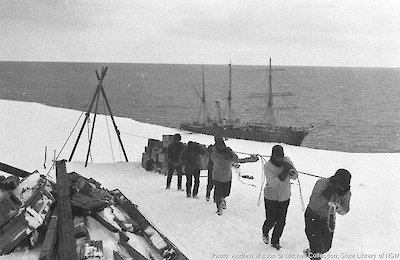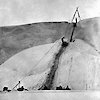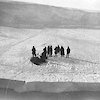Getting ashore
Getting stores ashore and inland to the selected site, about 600 metres from the edge of the ice shelf, needed to be done quickly. The ship needed to leave Antarctic waters as soon as possible, and the men needed to have their stores as far as possible from the edge, to avoid the regular calving of ice from the face of the ice shelf.
To raise the packages from the floe to the top of the ice shelf, [wrote Mawson], a ‘flying-fox’ was rigged. This consisted of a wire hawser strained taut between an anchor on the floe and the extremity of a pair of sheer-legs on the brow of the cliff. The packages were sent up slung on a travelling pulley. The ship’s crew ‘broke’ stores out of the hold and sledged them three hundred yards to the foot of the ‘flying-fox’, where they were hooked on and sent up to the top by the shore party.
The use of the flying fox dramatically hastened the process of landing stores, so that 32 tonnes of stores were lifted to the top of the ice cliffs within four days, ‘in all weathers’. Also landed were nine of the AAE’s 28 sledge dogs (the remaining 19 had already been landed at Cape Denison).
As Mawson wrote:
The parting came early on February 21, when the ship’s company gave their hearty farewell cheers to Wild and his seven companions who were to build a hut and reside during the ensuing year in novel and anxious circumstances.
Harrisson recorded Davis’s grim retort to Wild’s parting wishes for a safe journey: ‘If we don’t get to port, you will never be found again.’ This, said Harrisson, was ‘a truth that we had already realised’.
With the ship’s departure, Wild and his men climbed from the sea ice to the top of the cliff and moved remaining stores to the location of their winter quarters. Wild wrote that ‘as the edge of the glacier was very badly broken, I was anxious to get a supply of food, clothing and fuel moved back from the edge to safety as soon as possible.’



